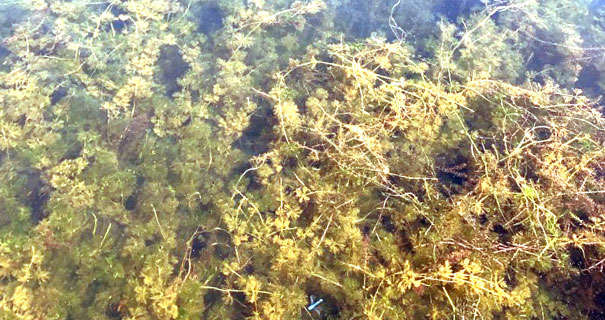In May, the Idaho State Department of Agriculture (ISDA) treated the North Arm for Curly Leaf Pondweed (CLP) using Galeon SC. This CLP-targeted herbicide carried only a minor impact on human water use. And, the results are positive. Remember that the objective of ISDA’s current treatment strategy is not to wipe out Curly Leaf in the short-term. Short-term efforts have short-lived results. Rather, their goal is to impact and reduce CLP’s long-term growth potential, reducing the noxious weed population to the point where it’s manageable without broad applications of herbicides.
Spring Treatment Area Looks Good!
To the desired effect, a survey of the north arm conducted only last week showed no new growth of Curly Leaf within the treatment area. At the edges of the treatment area, they observed some stressed and struggling CLP sprouts with malformed turions. Time and the on-going Turion Viability Study’s data collection will tell the bigger story of how effective Galeon treatments are. For now, rest assured, Curly Leaf Pondweed is not plaguing the North Arm – this month.
Eurasian Watermilfoil (EWM) is not an extensive problem right now either. Last year’s SonarOne and this year’s Galeon did a good job of reaching the EWM roots and shoots and suppressing its growth. That’s how a systemic herbicide does its work – by getting inside the plant and disrupting the growth processes. ISDA did locate a few EWM plants in persistent locations, and they anticipate hand-pulling or herbicide treatments to keep a real bloom at bay. Watch ISDA’s Treatment Plan site for dates and exact locations by
What, then, are we seeing on the North Arm?
With the management of the invasive weeds, many people hope that a clean, sandy lake-bottom will show itself. That’s not the nature of the North Arm. The stories about the land under the water once being pastureland are true. The nutrients are plentiful in the soil and water. Sunshine penetrates the shallow depth. Together these factors make the North Arm a great habitat for plant growth. And since one or two invasive weeds aren’t hogging all the resources, the native species have room to grow at last!
While this is good news, some residents and recreators may not be fond of native species any more than they favor invasive species. Boat traffic appears to be chopping up the native plants, and weed mats are building up. We need to continue to conscientiously take care of the lake.
When managing native species, there are some important ideas to hold onto:
- Native plants are good for the lake. Their presence suppresses the growth of invasive species. As we all work so hard to keep invasive plants at bay, scouring the lake bottom of native plants would be counterproductive. To remove all plants from the lake-bottom is to create a welcoming environment for invasive species growth.
- Know your aquatic plants. What you are most likely seeing now is Big Leaf Pondweed, not Curly Leaf Pondweed. This plant has larger leaves than CLP, 1-2 inches wide instead of ½ – ¾ in. Its leaves are oblong in shape rather than uniform in width. Both Big Leaf and Curly Leaf have ruffled edges, but CLP’s are more pronounced. And, Big Leaf Pondweed is a native species. You may also be seeing Water Buttercup or White Water-crowfoot, popular Eurasian Watermilfoil look-alikes. The Buttercup or Crowfoot looks very fern-like when crowded in a dense weed-mat. When examined carefully, you will see that its leaflets splay out like a feather duster. EWM’s leaflets are orderly, growing in pairs along a leaf stem.
- ISDA manages officially classified Noxious and Invasive weeds, not native plants. You may feel that a plant is “noxious” because you don’t favor its looks, size, behavior, or location. But if it’s not formally identified as such by the State, ISDA has no jurisdiction over it.
How should we respond to native plant growth?
Just as with invasive weed growth, navigating motorized boats through weeds that are approaching the water’s surface will cut up the plants, jam propellers, and propagate the weeds. Don’t drive your boat through patches of aquatic plants.
The best action for the health of the lake is to cut, hand-pull, or rake native plants to reduce their density and keep them below a boat motor’s reach. If you must apply an herbicide, check to be sure the applicator has an NPDES Permit from the EPA, because an herbicide application is a point-source discharge of pollutants into the water. Ask that the applicator use a systemic herbicide tuned to the species of plant you need to control. And check that they communicate their area and rate of application to ISDA.
If, in your own weed management, you do happen to pull up an invasive specimen, be sure to share photos, location, and density information with ISDA. Jeremey Varley, ISDA Noxious Weed Manager, recently shared with me, “I do appreciate the personal reports of weeds on the lake to help keep us, as an agency, aware of what is happening on the lake when we are physically not on it ourselves.”




2 Responses
Where are the marker buoys, and when will the illegal buoys be removed
I’ve added a map of the new buoy locations on https://haydenlakewid.com/living-on-hayden-lake/buoy-install/. The five buoys designated for removal by IDL will be taken off the lake during the 14-buoy installation or just after it is complete.
Comments are closed.